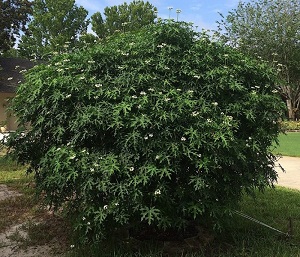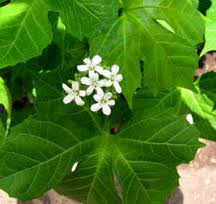From Eat the Weeds
and other things, too
by Green Deane
Cnidoscolus aconitifolius:
Tree Pot Herb
I
knew about Chaya long before I ever saw one.

Chaya leaves are edible after cooking 
It’s in the Cnidoscolus
genus and has two relatives in the southern United States, the Cnidoscolus stimulosus
and the Cnidoscolus
texanus. In researching and writing about those I learned
about the Chaya. The problem with the two American plants is the C. stimulosus has
an edible root and the C.
texanus has edible seeds, but one never finds good
evidence for the reverse. Are the seeds of the C. stimulosus
edible? Are the roots of the C.
texanus edible? There is also the possibility that the
leaves of the C.
stimulosus are edible. I know of two people who ate some
raw (blended it) and did not get ill. Another person used to fry the
leaves and eat them. This might suggest said for the C. texanus as well.
Those are four issues that need to be sorted out with the North America
family members, but there is no edibility issue with Chaya. Its leaves
are edible cooked. In fact, it’s an outstanding green
generally twice as nutritious as spinach, Chinese cabbage or amaranth.
The leaves are very high in protein, calcium, iron, carotene, and
vitamins A, B and C. In fact, Chaya can have 10 times as much vitamin C
as the orange. There is no doubt about its nutrition, there
is a bit of an issue, however, with how many Chaya there are. Whether
there is one species of Chaya with several scientific names or several
different species of Chaya is a bit of a debate.

Chaya in blossom
A study as late as 1999 researchers recognized two species, Cnidoscolus chayamansa
and Cnidoscolus
aconitifolius. At the time the C. chayamansa had
maple-like leaves (now called the chayamansa
variety) and the C.
aconitifolius had more indented five-lobed leaves (now
called the Estrella variety.) Those two botanical names are still used,
with some authorities saying they are two different species, and some–
the latest view since 2002 — saying they are the same plant, just
different varieties. You will also see Cnidoscolus aconitifolius
ssp. aconitifolius,
and Cnidoscolus
aconitifolius ssp. chayamansa,
and the reverse combinations. Botanists tend to defend their taxonomic
turf while confusing the issue significantly.
As for varieties, some have stinging hairs like their American cousins,
some don’t. So not only can you have multiple confusing names you can
have edible Chaya with stinging hairs and without, and different shaped
leaves. Often this is whether the variety is in the wild (Chaya brava)
or under cultivation (Chaya mansa.) Regardless, all should be boiled or
fried though there are some reports that some of the varieties can be
eaten raw. I would be careful about that since cooking drives off
hydrogen cyanide. You need to cook them ten to 20 minutes though some
say five minutes will do. (The resulting broth is also often consumed
because the hydrogen cyanide has been driven off and the water is full
of Vitamin C leached from the leaves.) The raw eaves can also
be used to wrap food for cooking.
Drying the leaves also reduces the hydrogen cyanide significantly.
Blending will do the same IF the blended leaves are allowed to sit for
several hours. The amount of hydrogen cyanide differs from variety to
variety and may account for reports of some variety leaves being eaten
raw. Researchers say they have found no reports of acute or
chronic effects attributed to the consumption of fresh or cooked Chaya
leaves. Still, it is better to err on the safe side.
While edibility is not an issue, finding Chaya may be. It’s native to
Central America and endemic to the Yucatan Peninsula. The USDA maps
show it naturalized only in Puerto Rico and Hawaii. It does grow in
Florida and South Texas but is ill- suited to freezes though it does
grow back from the root. One local specimen in downtown Orlando and has
been there at least 20 years, surviving several light freezes.
As for the scientific names, again opinions differ. Since the name is
from Greek first a little lesson in Greek. Greek verbs have a main
part, the stem, and an ending. The verb stem “to sting” is
“tsou.” To that is added endings telling you who or what is
stinging. Tsouzo (TSOU-zoh) means I sting, tsouzee, means he, she, it
stings. The word for nettles is tsouknitha (tsouk-NEE-tha) combining
tsou with knitha, which might mean “it stings a little.”
So the genus name Cnidoscolus
is from two Greek sources pulverized through Latin. Cnido is cleaved
from tsouknitha (k-NEE-tha) The Romans got rid of Greek “K”
sounds and used C in front of the N to indicate it was from Greek and
the C silent in Latin. Scolus
is from the Greek word “skolop” meaning “a thorn” but with a Latin
ending.
How that all is pronounced is a bit of preference. kah-knee-doe-SKOHL-us
is close to the original Greek, if you don’t mind cutting a word in
half and adding a Latin ending. Anglicized Latin truly
bastardizes the Greek, drops a syllable, changes the accent and
pronunciation ending up with nye-DOSE-ko-lus.
I have also heard sss-need-doe-SKOHL-us which offends both languages.
There is no beginning SN sound in native Greek or Latin.
Chayamansa
(chay-uh-MANZ-uh) a combination of the Mayan word for the plant,
“chaay” and the Latin mansa meaning house, dwelling or farm, read Chaya
a domesticated plant. It is also said chay-uh-MAN-suh. Aconitifolius
(a-kon-eye-tih-FOH-lee-us) means Aconitum-like leaves. Chaya is said
CHA-yah.
Green Deane’s
“Itemized” Plant
Identification:
Shrub to a small tree, three to 12 feet high, stems leafy, with or
without stinging hairs and or thorns. Leaves alternate, stalks two
inches to a foot long, three to five lobes, two smaller lobes at base,
leaf edges deeply, sharply lobed and toothed, veins palmate. Flowers
white, in branched clusters, spring through fall. Fruit three-part
capsule with stinging hairs. Sap milky. Rarely seeds.
Time of year:
Leaves and shoots year round. The best leaves are small to half mature
size. Up to 50% of the leaves can be harvested at one time.
Environment:
Will tolerate a wide range of environments from wet to arid, shady to
sunny.
Method of
preparation: Chopped leaves, stem tips and shoots boiled
or fried. Cooking for 20 minutes destroys hydrogen cyanide in the
tissue. Cooking broth is drinkable. Leaves can be blended and
consumed after letting them sit for several hours. Large leaves can be
used to wrap food for cooking. The entire plant can be dried, ground,
and used as fodder for animals or meal for fish.
Do not cook Chaya in aluminum containers. It can cause a toxic
reaction. When collecting stinging varieties wear gloves. Avoid
breathing in the vapors when cooking. Stir frying is not enough to
render the Chaya edible. Cook it first then add to stir fries.
Green Deane's
Disclaimer
Information
contained on this website is strictly and categorically intended as a
reference to be used in conjunction with experts in your area. Foraging
should never begin without the guidance and approval of a local plant
specialist. The providers of this website accept no liability for the
use or misuse of information contained in this website.
Back to
Chaya Page
|
|


